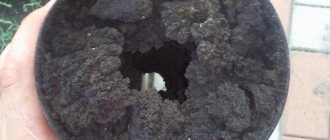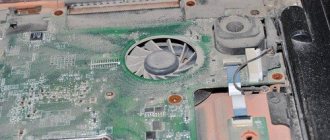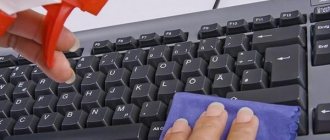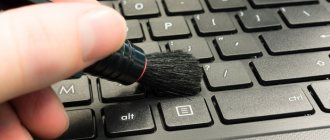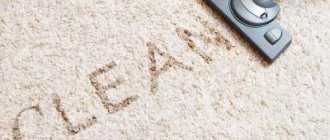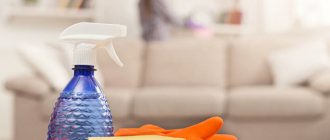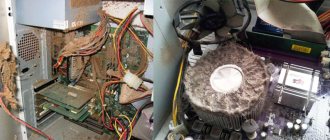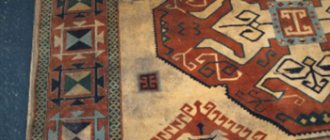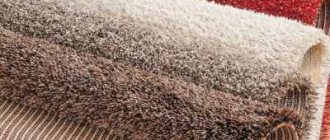In order for the books in your home library to please not only you, but also your child, they need to be well looked after. Dry cleaning twice a month. Moisture-resistant bindings should be washed with soap and water. Remove odors with baking soda and molds with boric acid.
Proper care not only prolongs the life of the publication, but also protects its owner from allergic reactions caused by paper dust. Let's find out how to clean books from dust, dirt, odors, and also remove mold stains.
Dry cleaning
If books are stored on closed shelves, we recommend cleaning books every two weeks:
- Remove the books from the cabinet and wipe down the surfaces first.
- Allow to air dry until interior surfaces are completely dry.
- Go to cleaning books.
- Wipe the lid with a dry microfiber cloth, wipe off dust from the sides and return it to its place.
Do not use a vacuum cleaner or hair dryer as dust particles will settle back on the surface.
Regular cleaning of bookshelves
It is better to remove book dust with a vacuum cleaner. The vacuum cleaner attachment kit includes a special brush with long bristles. It is just perfect for cleaning books.
You also need to thoroughly vacuum the shelves and wipe them with a damp cloth. Then wipe the book covers with a slightly dampened soft cloth. When cleaning books from dust, review them carefully; perhaps they require more thorough cleaning or minor repairs.
It is better to entrust especially expensive or antique books to a specialist for restoration, but you can remove stains and marks with a pen and pencil yourself.
Wet cleaning
This method is suitable for cleaning jobs with waterproof coating:
- Dirt should be removed from the side surfaces.
- Wipe the dust cover only with a slightly damp cloth.
- Contaminated areas should be wiped with a cloth moistened with soap or baking soda solution.
- Residues of detergent should be removed with a damp cloth.
- Leave the book to dry.
- You can use a hair dryer to speed up the drying process.
- Place the cleaned items on the bookshelf.
IMPORTANT: Never leave books to dry in direct sunlight.
Recommendations for the care and storage of books
- In glass cabinets, dust settles less on book volumes.
- Paper books deteriorate when exposed to direct sunlight.
- A temperature of 18-21 ℃ is considered optimal for storing paper literature.
- Humidity in the room should be no more than 55%.
- Place paper books on shelves vertically (if piled up, they become deformed).
- It is necessary to leave a little space between books (for free air circulation).
- It is better to cover the top row of a high rack with film (it will not be visible below). This will simplify care and extend the life of the books (just wipe the film with a damp sponge).
Traditional methods (activated carbon, tangerine peel) perfectly prevent the appearance of mold and moths in bookcases. Wet cleaning of bookshelves must be carried out every season (at least once a year). First, using thin attachments on a vacuum cleaner, vacuum starting from the top shelves. Books also need to be vacuumed, starting from the top of the folio, then the spine and only then the back of the book.
Then you can start cleaning the bookshelves themselves. After thoroughly vacuuming the books and shelving, you need to take them out and wipe them with a damp cloth (preferably microfiber). For antiseptic treatment, you can wipe the spines of books with a 2-3% formaldehyde solution. You can buy formalin at any pharmacy. After treatment with formaldehyde, leave the books to dry thoroughly.
If the library is not large, you can take it outside and carefully shake them out by hand, slamming them shut with sharp claps. By following these simple recommendations for proper care and storage of the library, it will last for decades and will delight more than one generation of readers.
Getting rid of the smell
Over time, a popular book not only wears out, but also acquires a characteristic smell. A panacea with which any housewife can get rid of it:
- Cover the table with a piece of cloth or newspaper.
- Cover the prepared surface with a bag of baking soda; if there are any lumps, crush them.
- Sprinkle the powder over the book, pouring it between the pages and completely covering the cover.
- Leave for 5-6 hours.
- Shake any remaining baking soda out of the sink.
Borax powder can be used instead of sodium bicarbonate. Both have disinfectant properties.
Urgent removal of grease stains from paper
To quickly remove grease stains from paper, you will need (optional):
- blotter;
- bread crumb;
- White clay;
- chalk;
- starch;
- flour.
These substances are used as an absorbent that will absorb the oil stain. Instead of a blotter, you can use a napkin or paper towel. To remove a greasy stain from paper, you need:
- Place a blotting cloth on the problem area.
- Iron the blotter with a warm iron.
- As the blotter gets dirty, cover the stain with a clean napkin.
Before removing grease stains from a notebook or other sheets of text, the iron must be heated to approximately 40–50 degrees. Otherwise, the blotter will absorb the ink.
Cleaning pulp is used if there are no other means at hand. To remove fat, use black bread, from which you need to tear off several pieces. Next, you need to rub the crumb into the stain. Crumbs that have absorbed fat (oil) should be brushed off immediately. These manipulations must be repeated until the contamination disappears.
There is a faster way to remove oil stains. In this case, you need to crumble chalk over the contaminated area, covering the crumbs on top with a sheet of clean paper. After this, the latter must be ironed with a heated iron.
Instead of chalk, you can use finely ground salt, which also absorbs fat and oil well.
A similar result is demonstrated by flour, which must be applied to the contaminated area and wait 20 minutes. At the end of the specified period, the grain grinding should be removed with a soft cloth.
For more serious cases, it is recommended to take white clay or starch.
In the first case you need:
- Mix white clay with water in equal proportions.
- Apply the mixture to the contaminated area.
- Wait until the mixture is completely dry.
- Remove dry clay with a rag.
To remove stains on paper with starch you will need:
- Dissolve a teaspoon of starch in 100 ml of clean water.
- Using a pipette, apply the mixture to the greasy stain.
- Wait until the paper is completely dry.
- Remove dried starch with a soft cloth.
Starch is also used to remove stale stains. But in this case, this method is less effective.
Removing contaminants
To restore your tomes to their original condition, follow these steps:
- Use a rag or sandpaper to remove paint, cement and other stains.
- Removing blood or insect deposits with hydrogen peroxide can be a quick and painless process.
Advice
. Prevention is always better than cure, so before reading, cover the source of knowledge with a lid and do not eat while sitting in front of a book.
What can you use to remove a fresh stain?
There are seven effective ways to help get rid of fresh, recently appeared stains.
Bread crumb
A product made from bread crumb works well against oily marks. To clean the paper covering, perform the following sequence of actions:
- tear off a small piece of bread and moisten it with warm water;
- Wipe the surface with the torn and moistened crumb until traces of dirt disappear.
Salt
If stains appear on printed documents, you must choose the cleaning method carefully. Regular salt is suitable for working with such papers. Experts recommend using crushed salt with small granules. If necessary, it can be further crushed with a wooden mortar.
Then the salt is evenly distributed over the surface of the stain, covered with a paper sheet on top and pressed down with a warm iron.
White clay
Many people believe that white clay is only suitable for cleansing the skin on the face, but this is not true. It is also used to remove greasy marks from the surface of paper. First, it is mixed with warm water in a one to one ratio. Then the resulting paste is applied to the spot and left there for 20-25 minutes. After this, the clay is cleaned off with a brush or dry sponge.
Chalk
Some people don't have white clay on hand, so they often use regular chalk instead, which helps restore the surface of the paper and remove dry spots. First, small chalk pieces are ground into powder. Then it is scattered onto the contaminated area of paper and pressed with an iron.
Flour
Oatmeal is an effective remedy for removing grease from documents. It is effective only against fresh stains, so it should be used immediately after stains appear. The stain is covered with flour, which is gently rubbed into the stain.
Potato starch
In almost any home you can find potato starch, which can be used to erase greasy marks. Sprinkle the dirty area with starch and wipe with a soft cloth.
See also
How and with what to quickly wash blueberries from clothes at home
Blotting paper
Special blotting paper will help remove grease. It is placed on a dirty surface and then ironed with a warm iron. If the paper is wet with grease, it will have to be replaced.
Removing mold
High humidity is detrimental to paper media as it leads to the growth of fungi. If your book has been covered in unsightly spots of black mold, this medicine will help get rid of the mold:
Dry the product outdoors. Wipe off the top layer of mold dust with a dry cloth. Using a watercolor brush, apply the boric acid solution to the stain. Be careful not to damage the paper and remove dirt with a dry cloth. Dry the sheet. Iron through fabric. Handle any damage. page.
When removing mold stains, do not forget about your own safety; carry out the work in a gas bandage.
General recommendations
Cleaning methods must be selected so as not to damage the paper. Compliance with the following recommendations helps to achieve this:
- Use liquid products with extreme caution. Water can warp sheets and blur ink text.
- Do not rub the material intensively. Because of this, the leaf structure deteriorates and pellets form.
- Do not use specialized stain removers, which often leave new marks on the sheets.
- Before removing fat from a sheet of paper, the chosen method must be tested on a similar, but not desired material.
- Clean grease and oil stains immediately. This is especially important when contaminants need to be removed from thin sheets.
- Do not use aggressive substances when cleaning stains on colored and thin paper, as well as on sheets with printed text or designs.
- The more valuable the document, the more carefully you need to clean it.
In addition, if oil or grease gets on a book, then before cleaning, you need to place oilcloth or other material under the contaminated sheet to protect the remaining pages.
Simple ways to get rid of bedbugs
What to do if you find bedbugs in books? How to get rid of these insects on your own, without resorting to the help of professional exterminators? It should be noted that this task can be solved independently only in the case of mild contamination of the home. To destroy all bedbugs, it is necessary to carry out comprehensive treatment of the room, and not just disinfestation of bookshelves. Particular attention should be paid to furniture, paintings, household appliances, joints between wallpaper, baseboards and other secluded places.
When disinfesting books, you need to remove the bookshelves from the wall and remove all the books from there. Each of them must be carefully treated with an insecticidal agent, especially the bindings. It is worth noting that, in addition to bedbugs, carpet beetles, grinder beetles or book beetles, another name for which are book lice, can also live in books. They also cause damage to books. However, unlike bedbugs, these insects are absolutely safe for people.
Before starting disinfestation, the bookshelf must be removed
Parasites sense danger well and quickly hide in hard-to-reach places, so they need to be given special attention. You should also put all the things out of the closets and treat each item of clothing and furniture separately. Things after such disinsection must be washed in hot water. If a living or dead bedbug, its larva or eggs are found, this means that the bedbug is somewhere nearby. You need to try to find it and treat it with an insecticide.
If the product used has a strong odor, the room should not be ventilated immediately after disinfestation. It's better to leave the house for a while. When using a good product, the effect can be seen literally a few hours later. The death of the entire population occurs within 3-5 days. If the infection is severe, repeated treatment will be required. After all, if at least a few living insects, eggs and larvae remain, then restoration of the population is inevitable. Moreover, the use of the previous drug will not bring results. Therefore, in the fight against bed bugs, you need to use different control methods and drugs.
To achieve maximum efficiency of disinfestation, you should not clean the room immediately after its completion. You can only wipe door handles and tables with a rag soaked in a soda solution (250 g of soda per 10 liters of water). General cleaning can only be done after making sure that there are no more bedbugs in the apartment. There are also many folk methods of fighting bloodsuckers, which can be combined with chemical ones. For example, immediately after disinsection, you can place wormwood branches under the beds, near the baseboards, in closets and on bookshelves. This herb will enhance the effect of insecticides in pest control.
How to remove urine smell from a book?
Prepare a solution of 1 part vinegar to 3 parts water, pour it into a spray bottle and apply this spray to the stain, then wipe it with a damp cloth. Get rid of the smell
with cat
urine
. Mix the juice with water and wipe the stain with it.
Interesting materials:
How does a mini telephone exchange work? How does a mini camera work? How does the Venta air washer work? How does the Window Cleaner work? How does instant tanning work? How does Montelukast work? How does the Moscow metro work? How does a polyglot's brain work? How does an MRI machine work? How does Mskt work?
Work options
There are several ways to get rid of such unpleasant surprises. In many ways, the choice of the most suitable course of action depends on what kind of adhesive the sheets were glued to. There will be only three of them:
- PVA is not waterproof or a paste - this option is a simple one and there will not be any special problems.
- Waterproof PVA or Bustilat is a problem, since soaking it with water and simply removing the coating will not work.
- The most difficult case is that the glue is unknown, it cannot be soaked or chemically, only small pieces of material are mechanically removed.
In your case, you will have to figure out how to remove old newspapers from the wall, based on what adhesive composition was used. Sometimes the problem is solved quickly, but sometimes it will take a lot of time and effort.
What harm do bedbugs cause?
The main nuisance that bed bugs cause to humans is bites. They are the ones who deprive adults and children of normal healthy sleep, which is why their performance decreases, chronic fatigue and irritability occur. In addition, in people who are sensitive and prone to allergic reactions, rashes, itching and redness may occur on the skin, which cause great discomfort.
Having made a bite, the bug, unlike a mosquito, does not move to another part of the body. It moves slowly along the surface of the skin, making one bite after another and leaving a characteristic path behind it. This is one of the main signs that there are bedbugs in the house. The distance from one bite to another is 1-2 cm.
If a room is heavily infested with bedbugs, one person can count hundreds of bites on their body. After puncturing the skin, the insect begins to drink human blood - this takes about 10-15 minutes of his time. During this time, the bug sucks about 6 μl of blood, which is almost twice its own weight.
To maintain normal life, the bug needs to feed once every 4-5 days. Scientists have not yet been able to prove that these insects are carriers of diseases. But according to their research, the body of this pest may contain pathogens of dangerous diseases, for example, typhus, tularemia and others.
Bustilate, waterproof PVA and other similar compounds
This is where serious problems begin. Because in this case it will not be possible to quickly remove old newspapers from the wall, since adhesive mixtures of this kind hold the coating very tightly and do not get wet. You will have to use one of two methods: chemical or mechanical removal. Moreover, both have serious drawbacks - the chemicals are toxic, and mechanically removing the pasted paper takes a very long time and will require both time and effort.
At the same time, you won’t have much choice in such a situation - you still need to decide how to tear the newspaper off the walls, and you won’t be able to speed up the work in any case. Sometimes this method helps: with a sharp tool, like a spatula, grooves are made on the surface, through which water or chemical compounds will fall onto the base of concrete or plaster. The process will speed up and the work will go a little faster. However, this will not give serious progress. It is better to look for a suitable chemical composition that dissolves the adhesive film.
Important: you can only work with solutions that are intended for removing old coatings in well-ventilated areas. They are toxic and you can be poisoned by the fumes.
The mechanical method is tedious and time-consuming, but it is most effective - the entire layer is removed at once, which can also be soaked to speed up the process. In any case, you will have to work hard and for a long time to get the cleanest possible surface. At the same time, it is not recommended to leave pieces of paper - during further finishing they can swell with bubbles and ruin everything.
Simple solutions
If the paper glued to the walls can be soaked and then begins to move away from the base, you are in luck. Here you can understand how to remove newspapers from the walls very quickly. It is enough to simply moisten the entire surface with a spray bottle and wait a little - the old coating will come away from the base in large layers and you can even remove it with your hands. To speed up the process, you can use a spatula or other suitable tool.
Sometimes the layer gets wet, but it doesn’t come off too well. In such a situation, it is possible to apply the achievements of modern technology and the chemical industry. Equipment suitable for such work is presented in the form of an iron with a steam mode or a steamer. Hot steam speeds up the process of soaking the paper and the problem is solved easily. The chemistry is represented by special compounds for removing old coatings. How to work with it is written in the instructions for the specific mixture.
How to remove old marks
To remove old and dried stains, you will have to use more effective products.
Iron
Experts advise removing old fat using an iron. To do this, the dirty paper is covered with a blotter, which is pressed on top with a hot iron. Ironing is carried out for 5-7 minutes. This is enough for the greasy stain to evaporate.
Chalk powder
Powder made from chalk will help get rid of old marks and stains on documents. Sprinkle it on the problem area and spread it evenly over the surface. Everything is covered with paper on top and heated with an iron.
A mixture of refined gasoline and magnesium
If the stain cannot be removed by any means, you can use magnesium and gasoline. These ingredients are used to make a thick paste that is used to cover soiled documents. When it hardens, it is carefully peeled off with a knife.
Dentifrice
Tooth powder is considered an excellent absorbent that quickly absorbs fat particles. Before use, it is mixed with gasoline to form a thick mixture. The product is carefully applied to the paper with a brush. After 10-12 hours it is cleaned with a sponge.
Hydrogen peroxide
Hydrogen peroxide is known for its degreasing properties, thanks to which it is possible to get rid of traces of fat. To clean documents, you need to soak a cotton pad in hydrogen and wipe the stain.
Petrol
You can use gasoline to dissolve grease on a paper surface. It is carefully applied to the stain and rubbed with a cloth until the fat dissolves.
Turpentine
When cleaning dense coatings, it is better to use turpentine. It is heated to a temperature of 60-70 degrees. Then the heated liquid is applied to paper using a pipette and ironed.
What can damage a book?
The slightest dirt (and greasy marks) can damage the pages of the book, stick together or ruin them. Therefore, before you start reading, wash your hands with soap. You need to wash your hands long enough to have time to sing the popular song “Happy Birthday to You.” When you take a book from a shelf, support it by the spine.
Interesting materials:
What neutralizes red pepper in soup? What should you not do on Passover? What can't you do on Youtube? What not to do in a relationship? What can't you write to Alice? What can’t be planted after cabbage? What can't be planted next to beans? What should you read on the packaging of canned fish? What does the number 7 mean? Anything?



